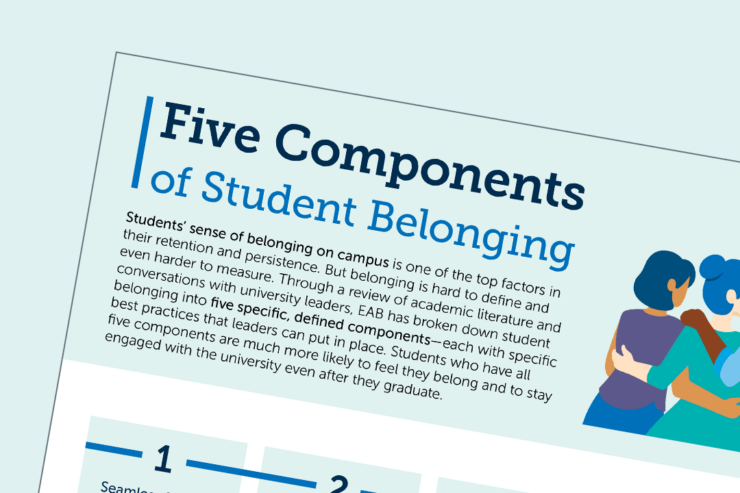What universities can do to advance student belonging
October 26, 2021, By Alexa Silverman, Senior Director, Student Experience and Well-Being Research
In the past couple of years, EAB has heard more and more questions from campus leaders about how to support students in feeling like they belong on campus. That makes sense-not only are we in the midst of a national conversation about racial justice, we are also experiencing a parallel rise in awareness around student mental health. While belongingness is a broad topic and can be hard to define, a growing body of academic research offers insights into what drives belonging-and why it’s important to support belonging and connectedness for every student.
Belonging matters for student success
Students who feel like they belong in college are more likely to stay in college and graduate [1][2]. Belonging and social integration also correlate with many of the things we know drive student success and lifelong fulfillment. Those include academic success and motivation, self-efficacy, a greater sense of self-worth, and overall mental wellbeing [3]. Students who feel like they belong on campus are also more likely to use support resources like advising and financial aid [4].
The good news is that most students do feel like they belong on campus. 90% of first-year students feel comfortable being themselves at their institutions, 80% feel valued, and 80% feel like part of the community, according to the National Survey of Student Engagement (NSSE) [1].
Belonging matters for student success
90%
of first-year students feel comfortable being themselves at their institutions80%
of first-year students feel valued at their institutions80%
of first-year students feel like part of the community at their institutionsHow do we measure a concept as broad as belonging?
In conversations with EAB partners, we hear repeatedly that student affairs leaders want to focus on belonging to support student success and advance DEIJ goals. But it’s hard to measure and to assess the impact of programs or initiatives on campus. Here’s what a few leaders told us:
“Survey data is really self-reporting. We don’t know what it really means, and it’s probably different for different students.”
Assistant Vice President, R1 University
“Belonging is such a broad term and such a broad concept that there is a lot of room for creativity…but it also makes it hard to identify what can actually transform a student’s experience.”
Vice President for Student Affairs, State Flagship University
“We’re always looking for strategies to better assess the work we do, but there’s no consistent formula for it across the board. Each program is different in terms of learning outcomes.”
Vice President for Student Affairs, Private Master’s University
What the evidence tells us about drivers of belonging
Luckily, university leaders don’t have to reinvent the wheel or puzzle out exactly what each student means when they talk about belonging. We can look at what the academic literature and research tells us about three key drivers of student belonging.
- Close relationships with faculty: Researchers find that students are more likely to feel like they belong in college if they have close relationships with faculty [3] as their mentors and supporters.
- Engaged and active learning: Faculty can also help increase belonging in other ways, by adding more opportunities for engaged and active learning into their pedagogy [5][6].
- Cocurricular and extracurricular participation: Belonging doesn’t start and end in the classroom, either. Participating in activities and sports also helps students feel like they belong on campus, by helping them make friends who can serve as informal support networks [7].
EAB has broken down student belonging into five specific components-each with specific best practices that leaders can put in place. To learn more about these components and how to address them, download our student belonging infographic.
Download our Student Belonging Infographic
Underrepresented students are getting left behind
As colleges diversify and students call for greater action around equity and social justice, it’s all the more important for college leaders to focus on creating campuses where every student can belong.
Unfortunately, belonging isn’t equal across all demographic groups. Students are less likely to feel like they belong if they are the first in their family to go to college [4]; if they come to campus as international students or identify as LGBTQ+ [1]; or if they face financial insecurity at home or have lower levels of academic preparation than peers [5].
University leaders can work to extend programs and opportunities that advance belongingness to underrepresented and minoritized students, but it’s also important for these students to feel represented on campus in the first place [3]. Students are more likely to feel like they belong when they can interact with faculty and staff who share their backgrounds [8]. That means your efforts to recruit and retain a diverse faculty and staff will also benefit students.
While campus DEIJ is a multifaceted, long-range effort, there are individual, discrete exercises also help improve belonging for underrepresented students. In two different experimental studies, Black and Hispanic students read and reflected on testimonials from upper-division peers about how they overcame belonging challenges and feelings of doubt, that these challenges are normal, and that students who experience them are not alone. Compared to control groups who read texts unrelated to belonging, study participants showed improved belongingness and GPA [9] [10].
Bring these practices to your campus
If you’d like to bring these practices to your institution, EAB can help. Our new Student Belonging Resource Center gathers together our research on helping students engage in active learning inside and outside the classroom, navigate campus resources, establish mental wellbeing, and develop closer relationships with faculty.
Sources
[1] NSSE. “Building a Sense of Community for All”: https://nsse.indiana.edu/research/annual-results/belonging-story/index.html.
[2] Doyle, William R. et al. Rethinking College Student Retention. United States: Wiley, 2013.
[3] University College London Teaching & Learning. “Creating a sense of belonging for your students”. 2020: https://www.ucl.ac.uk/teaching-learning/publications/2020/apr/creating-sense-belonging-your-students
[4] Gopalan, Maithreyi and Shannon T. Brady. 2019. “College Students’ Sense of Belonging: A National Perspective”. Educational Researcher 49 (2): 134-7. American Educational Research Association.
[5] Eddy & Hogan. 2014. “Getting Under the Hood: How and for Whom Does Increasing Course Structure Work?” CBE-Life Sciences Education 13(3): 453-468. https://doi.org/10.1187/cbe.14-03-0050
[6] Freeman, S., Haak, D., & Wenderoth, M. 2011. “Increased Course Structure Improves Performance in Introductory Biology”. CBE Life Sciences Education 10(Summer): 175-186.
[7] Weiss, Sabine. 2021.”Fostering sense of belonging at universities”. European Journal of Education 56 (1): 93-7. John Wiley & Sons, Ltd.
[8] University of North Carolina Greensboro. 2021. “iBelong Campus Climate Survey”. https://sa.uncg.edu/ibelong/
[9] Murphy, Mary C. et. al. 2020. “A customized belonging intervention improves retention of socially disadvantaged students at a broad-access university.” Science Advances 6 (29). DOI: 10.1126/sciadv.aba4677
[10] Walton & Cohen. 2007. “A question of belonging: Race, social fit, and achievement.” Journal of Personality and Social Psychology 92(1): 82. https://doi.org/10.1037/0022-3514.92.1.82

Featured Resource

5 Components of Student Belonging
More Blogs

What can TurboTax teach us about improving FAFSA completion?
